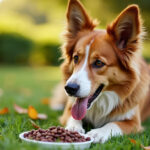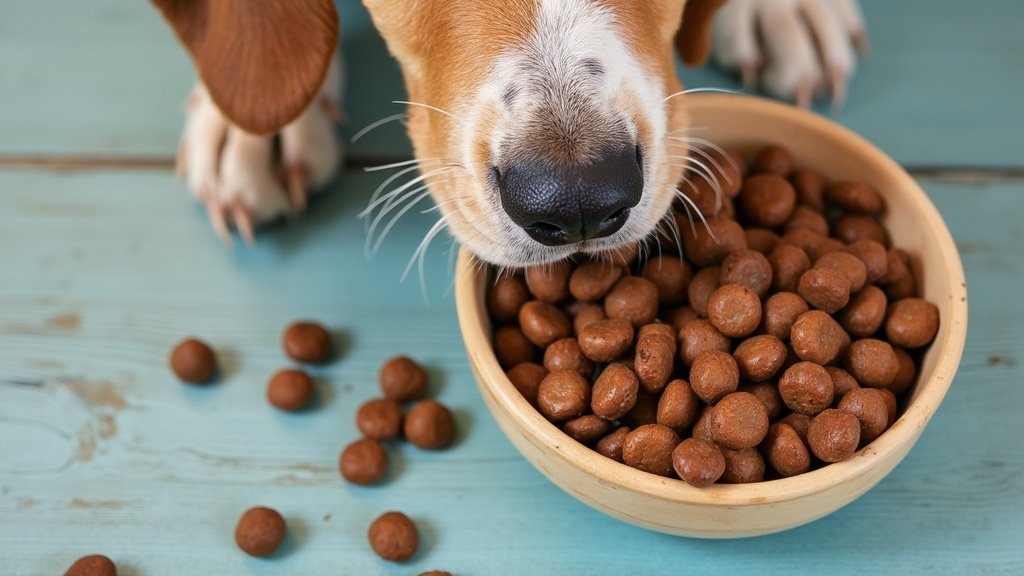Dog food allergies can be set off by everyday ingredients such as beef, chicken, and wheat. These allergies often cause red skin, persistent itching, and digestive problems. Vets typically suggest an elimination diet using hydrolyzed foods to pinpoint and handle these allergies. This approach helps identify specific triggers and sets the stage for long-term solutions.
Table of Contents
ToggleKey Takeaways:
- Frequent allergens include beef, chicken, lamb, wheat, soy, eggs, corn, and nuts
- Signs of dog food allergies include red skin, itching, ear infections, and digestive issues
- Hypoallergenic dog food choices include hydrolyzed, limited ingredient, and novel protein diets
- Slowly introducing new proteins and watching for reactions is vital when picking a hypoallergenic food
- Consistent vet visits and ongoing management are crucial for long-term allergy control
Understanding Dog Food Allergies: Causes, Symptoms, and Diagnosis
Dog food allergies can be a real pain for our furry friends. They’re often triggered by common ingredients like beef, chicken, lamb, wheat, soy, eggs, corn, and nuts. When a dog’s immune system overreacts to these allergens, it can weaken their skin barrier, leading to a host of uncomfortable symptoms.
Recognizing the Signs
I’ve seen various symptoms in dogs with food allergies. These can include:
- Red, inflamed skin
- Scabs and rashes
- Chronic itching
- Ear infections
- Sneezing
- Gastrointestinal issues
These symptoms often appear on the ears, paws, around the eyes, trunk, and limbs. If you notice your dog constantly scratching or showing any of these signs, it’s time to consult your vet.
Diagnosing Food Allergies
Pinpointing the exact allergen can be tricky. The most reliable method is an elimination diet trial, typically lasting 2-3 months. During this time, your dog is fed a diet free from common allergens. For accurate diagnosis, vets often recommend hydrolyzed foods like Hill’s® z/d or Royal Canin® Hydrolyzed Protein. These specially formulated diets break down proteins into smaller pieces, making them less likely to trigger an allergic response. This process helps identify the specific ingredients causing your dog’s discomfort, paving the way for effective long-term management.
Types of Hypoallergenic Dog Foods: Hydrolyzed, Limited Ingredient, and Novel Protein Options
Hydrolyzed Foods
Hydrolyzed foods break down proteins into tiny, amino-acid-sized pieces, making them less likely to trigger allergic reactions. Popular options include Royal Canin Veterinary Diets Hydrolyzed Protein, Hill’s z/d, and Purina Pro Plan Veterinary Diets. For dogs with severe allergies, limited ingredient foods offer a simpler solution. These diets feature fewer components and a single protein source. Consider trying Nom Nom Fresh, Wellness Simple, or Merrick Limited Ingredient Diet.
Novel protein foods introduce uncommon protein sources like duck, fish, venison, kangaroo, or even alligator. Blue Buffalo Natural Veterinary Diet NP Novel Protein Alligator and JustFoodForDogs Venison & Squash are excellent choices in this category. By exploring these options, you’ll find the perfect hypoallergenic food for your sensitive pup.
Top 7 Vet-Approved Hypoallergenic Dog Foods
Protein-Focused Options
Royal Canin Adult Ultamino Dry Dog Food leads the pack with its hydrolyzed poultry proteins and essential nutrients. For single-protein diets, Wellness Simple Limited Ingredient Diet offers lamb or turkey options, paired with gentle carbs and probiotics. JustFoodForDogs Venison & Squash provides a fresh food alternative, using venison as the sole animal protein.
Specialized Formulas
Blue Buffalo True Solutions Perfect Skin & Coat stands out with its omega-3 and -6 fatty acids from salmon and fish oil. For plant-based needs, Open Farm Kind Earth Premium Plant Kibble Recipe uses sweet potato and fava beans. Natural Balance Limited Ingredient Diet combines salmon and brown rice, avoiding common allergens. Purina Pro Plan Veterinary Diets rounds out the list with prescription-only hydrolyzed protein options.
Selecting the Right Hypoallergenic Food for Your Dog
Tailoring Your Approach
Choosing the perfect hypoallergenic food for your dog requires a thoughtful approach. I’ll guide you through the process to ensure your furry friend gets the nutrition they need without triggering allergies. First, it’s crucial to identify your dog’s specific allergies and sensitivities. This knowledge forms the foundation for selecting an appropriate diet.
Before making any dietary changes, consult with your veterinarian. They’ll provide valuable insights and help create a plan tailored to your dog’s needs. Once you’ve got the green light, introduce new proteins gradually. Here’s a step-by-step approach:
- Introduce one new protein every 2-4 weeks
- Allow 2-3 months for noticeable improvements
- Monitor your dog closely for any reactions
- Adjust the diet as necessary based on your observations
This careful process helps pinpoint which ingredients work best for your dog. Remember, patience is key. It might take some time to find the ideal food, but the results are worth it. Your dog’s health and comfort will improve significantly with the right hypoallergenic diet. Stay attentive to their response and don’t hesitate to make adjustments along the way. With persistence and care, you’ll discover the perfect meal plan for your sensitive pup.
Managing Dog Food Allergies: Best Practices and Common Mistakes
Effective Allergy Management Strategies
Tackling food allergies in dogs requires dedication and a systematic approach. I recommend sticking to an elimination diet for the full 2-3 months to accurately identify triggers. During this period, it’s crucial to avoid treats and table scraps, as they can skew results. Keeping a detailed food diary helps track reactions and improvements, providing valuable insights for both you and your vet.
Avoiding Common Pitfalls
Many pet owners make the mistake of rushing the process or introducing new foods too quickly. Patience and consistency are key when managing dog food allergies. Here are some common errors to avoid:
- Switching diets frequently without allowing enough time for results
- Forgetting to consider environmental allergies as a potential cause
- Neglecting to read ingredient labels carefully
- Assuming all “natural” or “organic” foods are allergy-friendly
By steering clear of these pitfalls and following a structured approach, you’ll be better equipped to manage your dog’s food allergies effectively. Remember, every dog is unique, so what works for one may not work for another. Stay vigilant, work closely with your vet, and be prepared to adjust your strategy as needed for the best results.
Expert Tips and Long-Term Management of Canine Food Allergies
Consistent Veterinary Care and Supplementation
I can’t stress enough the importance of regular vet check-ups for dogs with food allergies. These visits allow for close monitoring of your pet’s progress and timely adjustments to their diet if needed. To boost skin and coat health, I often recommend adding fish oil supplements to your dog’s meals. These omega-3 rich additions can help soothe irritated skin and promote a shinier coat.
Environmental Management and Dietary Vigilance
Keeping your home clean is crucial in managing your dog’s allergies. Regular vacuuming and dusting can significantly reduce allergen exposure, complementing the benefits of a hypoallergenic diet. It’s also vital to stay alert to any changes in your dog’s condition, as food allergies can evolve over time. You might need to adapt their diet accordingly.
Lastly, don’t forget to educate everyone in your household about your dog’s dietary needs. This includes family members, dog sitters, and anyone else who might feed your pet. Consider creating a simple guide with do’s and don’ts to ensure everyone’s on the same page. By following these tips, you’ll be well-equipped to manage your dog’s food allergies in the long term.
Sources:
PetMD
Michigan Avenue Animal Hospital
NBC News Select
Dog Food Advisor
Reddit













